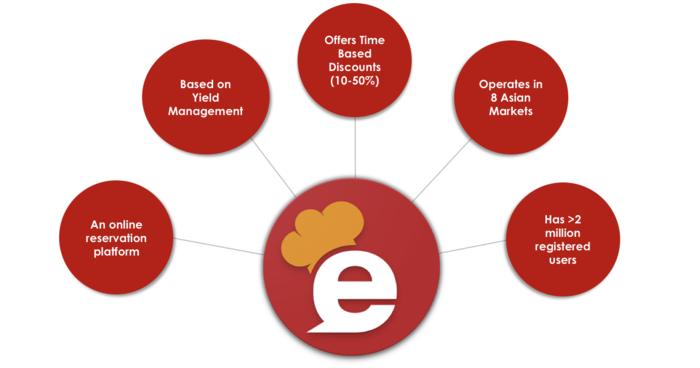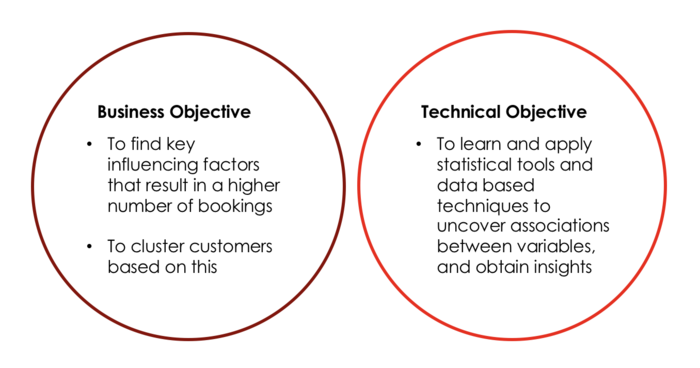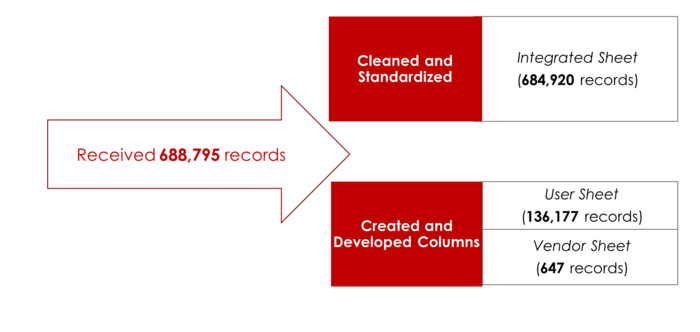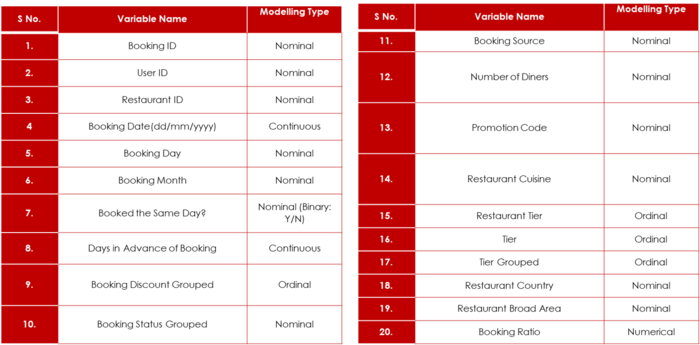Difference between revisions of "ANLY482 AY2017-18T2 Group01: Project Overview"
| (16 intermediate revisions by 2 users not shown) | |||
| Line 30: | Line 30: | ||
<div style="background:#AE0000; line-height:0.3em; font-family:montserrat; font-size:120%; border-left:#FFE2C0 solid 15px;"><div style="border-left:#fff solid 5px; padding:15px;"><font color="#fff"><strong>'''Project Background''' | <div style="background:#AE0000; line-height:0.3em; font-family:montserrat; font-size:120%; border-left:#FFE2C0 solid 15px;"><div style="border-left:#fff solid 5px; padding:15px;"><font color="#fff"><strong>'''Project Background''' | ||
<font color="#fff"></font> </strong></font></div></div> | <font color="#fff"></font> </strong></font></div></div> | ||
| + | |||
| + | |||
| + | [[File: Abouteatigo1.png|700px|centre| upright=6]] | ||
<div style="color:#212121;"> | <div style="color:#212121;"> | ||
| − | Our project sponsor, eatigo, currently has 2 million registered users. However, reservation and reactivation rates remain low as only 30% of eatigo's subscribers have ever made a reservation. Further, even amongst this 30%, each customer makes only 1.6 bookings on average per month. Our sponsor believes that there is higher potential, given their presence in markets such as Singapore and Thailand, both of which | + | Our project sponsor, eatigo, currently has 2 million registered users. However, reservation and reactivation rates remain low as only 30% of eatigo's subscribers have ever made a reservation. Further, even amongst this 30%, each customer makes only 1.6 bookings on average per month. Our sponsor believes that there is higher potential, given their presence in markets such as Singapore and Thailand, both of which are amongst the top 3 spenders in South-East Asia when it comes to dining out. Our sponsor is very keen on making eatigo a 'habit' service, such that when people thinking of dining out, they think of booking through eatigo. |
| − | |||
| − | |||
| − | + | With this overarching objective, our project aims to set the initial steps in understanding the distinctive customer profiles within the entire base. This would help eatigo understand which customers they need to focus on more and the key booking patterns across all their customers. | |
<div style="background:#AE0000; line-height:0.3em; font-family:montserrat; font-size:120%; border-left:#FFE2C0 solid 15px;"><div style="border-left:#fff solid 5px; padding:15px;"><font color="#fff"><strong>'''Objectives''' | <div style="background:#AE0000; line-height:0.3em; font-family:montserrat; font-size:120%; border-left:#FFE2C0 solid 15px;"><div style="border-left:#fff solid 5px; padding:15px;"><font color="#fff"><strong>'''Objectives''' | ||
<font color="#fff"></font> </strong></font></div></div> | <font color="#fff"></font> </strong></font></div></div> | ||
| + | |||
| + | [[File: Eatigoobj.png|700px|centre| upright=6]] | ||
Based on this background, the objective of our project is as follows: | Based on this background, the objective of our project is as follows: | ||
1. Business Objective: | 1. Business Objective: | ||
| − | To find the | + | To understand and find variations in the number of bookings and booking patterns of customers, and to identify ways of developing distinctive customer profiles based on this. |
2. Technical Objective: | 2. Technical Objective: | ||
| − | To learn and apply statistical | + | To learn and apply statistical techniques to uncover associations between various variables, so that we can use to fulfill the business objective. |
| − | <br> | + | <br> i. Understand the Data |
| − | <br> | + | <br> ii. Identify the booking patterns across customers |
| − | + | <br> iv. Cluster the customers based on key booking variables | |
| − | <br> | + | <br> v. Understand interpretation of clusters |
| − | <br> | ||
| Line 63: | Line 65: | ||
We have have data about the following categories: | We have have data about the following categories: | ||
# Vendor Data | # Vendor Data | ||
| − | # | + | # User Data |
| − | # | + | # Reservation Data |
| + | |||
| + | We combined these tables into a consolidated sheet and had 688795 records of raw data. After cleaning, we have 684920 records. We also made a User Sheet and Vendor Sheet for specific clustering analysis. | ||
| + | |||
| + | [[File: EatigoData.png|700px|centre| upright=6]] | ||
| − | + | Due to confidentiality, we cannot share our data records and analysis. However, here is a glimpse into our metadata (the key variables) and a link to more comprehensive metadata : | |
| + | <br /> | ||
| − | + | [[File: Wiki_MainTable_Meta.png|700px|centre| upright=6]] | |
| + | <br /> | ||
| − | {| class="wikitable" | + | {| class="wikitable" |
| + | |- | ||
| + | |[[Media:Interim_MetaDataAnalysis_Group1_final.pdf|Link to Metadata1 (For EDA)]] | ||
|- | |- | ||
| − | |[[Media: | + | |[[Media:UserClusteringSheet_Metadata_Group01.pdf|Link to Metadata2 (For Clustering)]] |
|} | |} | ||
| − | |||
'''References:''' | '''References:''' | ||
| Line 81: | Line 90: | ||
"What's Next for the Sharing Economy" (https://www.bcg.com/en-sea/publications/2017/strategy-technology-digital-whats-next-for-sharing-economy.aspx) | "What's Next for the Sharing Economy" (https://www.bcg.com/en-sea/publications/2017/strategy-technology-digital-whats-next-for-sharing-economy.aspx) | ||
| − | [[https://wiki.smu.edu.sg/ANLY482/ANLY482_AY2017- | + | [[https://wiki.smu.edu.sg/ANLY482/ANLY482_AY2017-18T2_Group01%3A_Project_Findings<font color="Blue">Read about our Findings! </font>]] |
<!-- End Information --> | <!-- End Information --> | ||
Latest revision as of 18:58, 15 April 2018
Our project sponsor, eatigo, currently has 2 million registered users. However, reservation and reactivation rates remain low as only 30% of eatigo's subscribers have ever made a reservation. Further, even amongst this 30%, each customer makes only 1.6 bookings on average per month. Our sponsor believes that there is higher potential, given their presence in markets such as Singapore and Thailand, both of which are amongst the top 3 spenders in South-East Asia when it comes to dining out. Our sponsor is very keen on making eatigo a 'habit' service, such that when people thinking of dining out, they think of booking through eatigo.
With this overarching objective, our project aims to set the initial steps in understanding the distinctive customer profiles within the entire base. This would help eatigo understand which customers they need to focus on more and the key booking patterns across all their customers.
Based on this background, the objective of our project is as follows:
1. Business Objective: To understand and find variations in the number of bookings and booking patterns of customers, and to identify ways of developing distinctive customer profiles based on this.
2. Technical Objective:
To learn and apply statistical techniques to uncover associations between various variables, so that we can use to fulfill the business objective.
i. Understand the Data
ii. Identify the booking patterns across customers
iv. Cluster the customers based on key booking variables
v. Understand interpretation of clusters
We have have data about the following categories:
- Vendor Data
- User Data
- Reservation Data
We combined these tables into a consolidated sheet and had 688795 records of raw data. After cleaning, we have 684920 records. We also made a User Sheet and Vendor Sheet for specific clustering analysis.
Due to confidentiality, we cannot share our data records and analysis. However, here is a glimpse into our metadata (the key variables) and a link to more comprehensive metadata :
| Link to Metadata1 (For EDA) |
| Link to Metadata2 (For Clustering) |
References:
“Singapore Among Top Spenders, Asia Pacific Survey” (http://www.todayonline.com/singapore/singapore-among-top-spenders-asia-pacific-dining-survey) “How Eatigo has Disrupted the Food Space.” (https://ecommerceiq.asia/eatigo-food-commerce/) "What's Next for the Sharing Economy" (https://www.bcg.com/en-sea/publications/2017/strategy-technology-digital-whats-next-for-sharing-economy.aspx)



